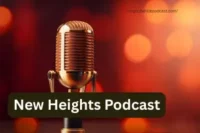Podcast Interview Setup Tips for Clear Audio & Flow
Published: 25 May 2025
Starting a podcast is exciting, but when it comes to interviews, your setup can make or break the experience. Whether you’re hosting from your home or connecting remotely, having the right tools and environment ensures clear audio, smooth conversation, and a professional feel that your listeners will appreciate.
Podcast Interview Setup In this guide, we’ll walk you through everything you need for— from must-have gear to smart tips for better recording.

Why Podcast Interview Setup Matters
Your podcast setup isn’t just about fancy equipment — it directly affects how your audience and guest experience the show. A good setup ensures your voice is clear, your guest sounds professional, and the entire conversation flows without distraction or technical issues.
Here’s why it really matters:
- Clearer Audio = More Listeners: Listeners often leave podcasts with poor sound quality.
- Professionalism: A solid setup makes you sound credible and serious.
- Better Guest Experience: Guests feel more comfortable when everything works smoothly.
- Less Editing Hassle: Clean recordings save time and energy later.
🎧 Essential Equipment You Need for Podcast Interviews
You don’t need a full studio to record a great podcast interview — just the right basic tools that fit your budget and needs. Start simple, then upgrade as you grow.
🔧 Here’s what you’ll need:
- Microphone – USB mics like Blue Yeti or Samson Q2U are perfect for beginners
- Headphones – Closed-back headphones help you monitor audio clearly
- Pop Filter – Reduces “p” and “s” sounds for smoother speech
- Mic Stand or Boom Arm – Keeps your mic stable and close to your mouth
- Audio Interface – Only needed if you use an XLR mic (e.g., Focusrite Scarlett)
- Recording Software – Free tools like Audacity, GarageBand, or online options like Riverside.fm and Zencastr.
- Become a Pro Podcast Interviewer:
🌐 Remote Interview Setup Tips
Remote podcast interviews are super convenient, especially if your guest is in another city or even another country. But to make them sound as good as in-person recordings, you need to be prepared. A smooth remote setup keeps both the guest and audience happy while reducing editing headaches.
- Here are key tips to make your remote interviews sound professional:
- 7 Types of Interview Podcasts
✅ What You Should Do:
- Use a Stable Internet Connection
- If possible, always use a wired connection. If using Wi-Fi, sit close to your router to avoid dropouts or lag.
- Choose the Right Recording Platform
- Use podcast-friendly tools like Riverside.fm, Zencastr, or SquadCast. These platforms record locally and upload high-quality audio, reducing glitches.
- Ask Guests to Use Headphones
- This prevents echo and audio feedback. Even regular mobile earphones are better than nothing.
- Send Setup Instructions Before the Call
- Let your guest know about lighting, background noise, mic placement, and internet needs before recording day.
- Do a Quick Test Call
- Jump on a 5-minute call before the actual session to check audio, video (if used), and environment.
- Have a Backup Plan
- Keep Zoom or another recorder running in the background as a safety net in case your main tool fails.
- 100 Podcast Interview Questions for an Engaging Interview
In-Person Interview Setup Tips
Recording in-person interviews can give you rich, natural conversations and better chemistry with your guest. But for great results, your environment and equipment setup need to be just right. Let’s break it down step by step.
📍 Choose the Right Location
Pick a quiet, echo-free room. Avoid places with hard surfaces that reflect sound. Carpet, curtains, and soft furniture help absorb noise.
🎙️ Use Two Microphones
Never share one mic! Use a separate microphone for each speaker. USB mics work, but XLR mics with an audio interface give better quality.
🧑🤝🧑 Sit at the Right Distance
Place the microphones about 6–8 inches from each person’s mouth. Use mic stands or boom arms to keep them stable and hands-free.
🎧 Monitor with Headphones
Plug in headphones to check your audio live. This helps you catch any background noise or audio clipping early.
💡 Bonus Tip: Treat the Room (If You Can)
If you record regularly in one space, invest in a few foam panels or blankets on walls. It really improves sound quality over time.
In-Person Podcast Setup – Keep It Simple & Clear
Recording in person can be powerful — the natural flow of conversation, fewer delays, and stronger chemistry. But to get that crisp, professional sound, your setup needs to be intentional, even if it’s at home.
Here’s what really matters when setting up in person:
🏡 Room Environment
- Choose a small, quiet room with soft surfaces (curtains, carpets, cushions).
- Avoid big, empty rooms — they echo and hurt sound quality.
🎤 Microphone Setup
- Use two microphones (one for each person).
- Prefer dynamic mics — they’re better at reducing background noise.
- Mic placement: 6–8 inches from the mouth, angled slightly to avoid popping sounds.
🎧 Gear & Monitoring
- Headphones for both you and your guest help detect problems early.
- Use a mic stand or boom arm to avoid handling noise.
🪑 Comfort Matters
- Give your guest a comfy seat and water.
- Keep your recording gear organized and non-intimidating.
✅ Pro Tip:
- Record a 10-second test before the real interview. Check for clarity, background sounds, and mic levels.
Focus on Lighting & Background – It Sets the Mood
If you’re recording a video podcast, your setup isn’t just about sound — it’s also about how things look. Clean visuals help your podcast look more professional and keep viewers focused on the conversation, not the clutter in the background.
Start with natural light if you can. Facing a window gives you soft, even lighting that flatters everyone. But if you’re recording in the evening or in a dark room, use a ring light or softbox for balanced lighting — one in front, maybe one to the side.
As for the background? Keep it simple. A plain wall, bookshelf, or even a cozy plant can make a big difference. Avoid distracting stuff like cluttered shelves, messy desks, or flashy posters. You want your audience to stay focused on you and your guest — not what’s behind you.
Quick Tips:
- Face your light source (never behind you)
- Use warm light settings for a relaxed vibe
- Test camera angle and background before recording
- Keep it consistent if you’re building a visual brand.
Best Practices for Interview Flow
Even with the best gear and setup, a podcast can feel flat if the conversation doesn’t flow naturally. A well-paced, engaging interview keeps your audience listening — and your guest feeling comfortable.
Start by making your guest feel relaxed. A quick pre-interview chat can help break the ice. Let them know how things will go, what to expect, and that you can always edit out awkward moments.
📝 Here’s how to guide the conversation smoothly:
Prepare a Loose Script
- Have 5–7 questions ready, but don’t stick to them too rigidly. Let the conversation breathe and follow interesting tangents naturally.
Start with Softball Questions
- Begin with easy, open-ended questions that help your guest ease into the conversation.
Listen Actively
- Don’t just wait for your turn to speak. Listen carefully and ask follow-up questions based on what your guest says. This makes the chat feel real — not robotic.
Watch the Time
- Try to keep each segment focused. If your episodes are 30 minutes, aim to wrap each main topic in 5–7 minutes.
Use Smooth Transitions
- Lead into the next topic naturally: “That’s really interesting — it actually ties into something else I wanted to ask…”
Wrap Up Gracefully
- Give your guest a chance to plug their work or leave final thoughts. Then thank them warmly before signing off.
Conclusion:
Setting up the perfect podcast interview might seem like a big task, but when you break it down step by step — from gear to guest flow — it becomes totally manageable. Podcast Interview Setup Whether you’re recording in person or online, what really matters is creating a smooth, comfortable experience for both you and your guest.
Remember, great content isn’t just about fancy equipment. It’s about being prepared, making your guest feel at ease, and delivering clear, engaging conversations.
Question: Which of the following is NOT essential for a smooth podcast interview setup?
A) Using headphones during recording
B) Recording in a noisy room with lots of echo
C) Testing your internet connection before remote interviews
D) Preparing a list of questions for the interview
Answer: B) Recording in a noisy room with lots of echo

- Be Respectful
- Stay Relevant
- Stay Positive
- True Feedback
- Encourage Discussion
- Avoid Spamming
- No Fake News
- Don't Copy-Paste
- No Personal Attacks

- Be Respectful
- Stay Relevant
- Stay Positive
- True Feedback
- Encourage Discussion
- Avoid Spamming
- No Fake News
- Don't Copy-Paste
- No Personal Attacks






